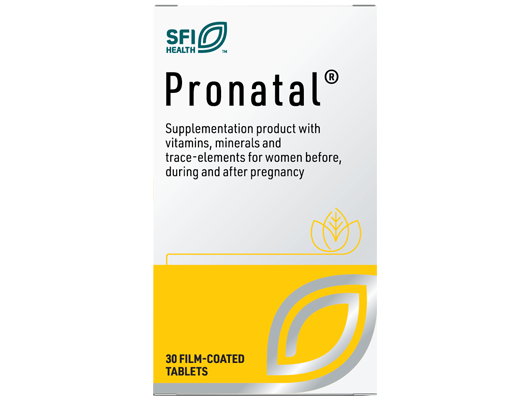
Are you thinking about pregnancy? Or are you pregnant? Did you know that before and during pregnancy your body goes through many changes that require use of additional micronutrients needed to support normal growth and development.
Pronatal is a multivitamin/multimineral combination that covers the micronutrient needs of women planning to become pregnant, those who are already pregnant, right through to those who are breastfeeding.

Pronatal’s formulation is based on recommended Dietary Reference Intakes (DRIs)1 for most of its ingredients, to cover the needs for pregnant women.
Each tablet of Pronatal provides the recommended amount of critical micronutrients to support pregnancy.
Food for thought: Did you know that 75% of pregnant women are likely to be deficient in at least one vitamin?6 Find out more about how supplements can help cover the needs of women who are or are planning to become pregnant.
Health and dietary supplements can vary based on the combination and amounts of active components or ingredients within them. Pronatal is developed to cover the increased needs of micronutrients in pregnant women, women intending to be pregnant and lactating women. The choice of the ingredients and its dosages are scientifically based and specifically dedicated to these groups.
Using Pronatal
Recommended dosage and directions
Adult / women of childbearing age who are intending to become pregnant, are pregnant or are breastfeeding: take 1 tablet in the morning with breakfast and some liquid
Always read the label. Follow the directions of use. Packaging and product claims may vary depending on country-specific regulations. Products available in selected markets only.
Tolerability
Pronatal is considered to be well-tolerated product. A review of safety reports was conducted in 2004 and showed no serious safety issues had been reported.
Contains


Each tablet of Pronatal provides the recommended amount of critical micronutrients essential for pregnancy.
There are some known interactions of iron with tetracycline antibiotics, so use of them together may impact the absorption of each. 8-10 As with any other iron-containing minerals, combined use of Pronatal and these antibiotics should be avoided where possible, or if not possible, try waiting 3 hours between each.
High doses of folic acid may also reduce the effect of anti-epilepsy/anti-convulsion drugs. 8,9
Be sure to speak with your healthcare provider if you have any questions about medicines you are taking.
No efficacy clinical studies have been carried out with Pronatal due to the highly regulated nature of testing any products in pregnant women.
However, studies of each of the ingredients in Pronatal exists, and Pronatal has the required amounts for most of its ingredients required for women during pregnancy based on USA recommended dietary reference intakes.
Pronatal is only indicated for adult women of childbearing age. If you have specific questions or concerns, it is important to speak with a healthcare professional.
No, Pronatal is not suitable for vegans/vegetarians as it contains fish gelatin and lactose.
Yes, Pronatal film-coated tablets contains 1 mg of sucrose, 0.9 mg of glucose and 1 mg of lactose per tablet. Patients with the hereditary condition of fructose intolerance should not take Pronatal.
The iron content of Pronatal may in some cases cause nausea if the product is taken on an empty stomach.
It is recommended to take Pronatal with food (preferably at breakfast).
High doses of vitamin A could be harmful and potentially increase the risk of teratogenicity (fetal malformations).5 Pronatal uses beta-carotene, which is neither toxic nor teratogenic and a well-tolerated precursor of vitamin A.5
Pronatal is available in selected markets. Please contact us for further information.
Packaging and product claims may vary depending on country-specific regulations. Products available in selected markets only.
*The International Council for Harmonisation of Technical Requirements for Pharmaceuticals for Human Use (ICH), Good Manufacturing Practices (GMPs) and Hazard Analysis and Critical Control Points (HACCP)
References
1. National Institutes of Health. Nutrient recommendations: dietary reference intakes (dri). Available at: https://ods.od.nih.gov/Health_Information/Dietary_Reference_Intakes.aspx
Accessed December 2018
2. Commission Regulation (EU) No. 432/2012.
3. Greenberg JA, et al. Rev Obstet Gynecol. 2011;4(2):52-59
4. Commission Regulation (EU) No 1135/2014.
5. Rothman KJ, et al. N Engl J Med. 1995; 333:1369-1373.
6 Baker H, et al. J Am Coll Nutr. 2002;21(1):33-37.
7. Makrides M, et al. Am J Clin Nutr. 2003;78:145-153.
8. Weber M, et al. Rev Neurol (Paris). 2003 Feb;159(2):165-70.
9. Eichholzer M, et al. Schweiz Rundsch Med Prax. 2002 Jan 9;91(1-2):7-16.
10. Neuvonen PJ. Drugs. 1976; 11(1):45-54.
Lifestyle insight
A mother's needs for micronutrients increase substantially during her child's early development. Prenatal supplements are designed to make sure you get everything you need.